Fabergé egg
A Fabergé egg is one of the jewelled eggs made by Peter Carl Fabergé and his company between 1885 and 1917.[1]

Rose trellis egg
The most famous are those made for the Russian Tsars Alexander III and Nicholas II. They were Easter gifts for their wives and mothers, and are called the 'Imperial' Fabergé eggs. The House of Fabergé made about 52 imperial eggs, of which 46 have survived.[2] Two more were planned for Easter 1918, but were not delivered, due to the Russian Revolution.[3]
List of Fabergé Tsar Imperial Easter eggs
Below is a list of the eggs made for the Russian imperial family.[4]
| Date | Egg | Image | Description | Owner |
|---|---|---|---|---|
| 1885 | First Hen Egg |  | Also known as the Jewelled Hen Egg, it was the first in a series of 54 jeweled eggs made for the Russian Imperial family under Peter Carl Fabergé's supervision. The tsarina and the tsar enjoyed the egg so much that Alexander III ordered a new egg from Fabergé for his wife every Easter | Viktor Vekselberg Viktor Vekselberg - Wikipedia |
| 1886 | Hen egg with sapphire pendant | Also known as the Egg with hen in basket, it was made in 1886 for Alexander III, who presented it to his wife, the Empress Maria Feodorovna | LOST | |
| 1887 | Third Imperial Egg |  | A jewelled and ridged yellow gold egg with Vacheron & Constantin watch. It is on its original tripod pedestal. In 2014, it was bought by London-based jeweler Wartski on behalf of a private collector.[5] | Private Collection |
| 1888 | Cherub with chariot Egg | 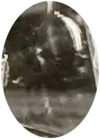 | Also known as the Angel with egg in chariot, made and delivered in 1888 to Alexander III. This is one of the lost Imperial eggs. Few details are known about it | LOST |
| 1889 | Nécessaire Egg | Crafted and delivered to Alexander III, who presented it to his wife, Maria Feodorovna, on Easter 1889. | LOST | |
| 1890 | Danish palaces Egg |  | Crafted and delivered to Alexander III, who presented it to his wife, Maria Feodorovna, on Easter 1890. | Matilda Geddings Gray Foundation.[6] |
| 1891 | Memory of Azov Egg |  | Kremlin Armoury, Moscow, Russia | |
| 1892 | Diamond trellis Egg |  | Private collection | |
| 1893 | Caucasus Egg |  | Matilda Geddings Gray Foundation.[7] | |
| 1894 | Renaissance Egg |  | Viktor Vekselberg | |
| 1895 | Rosebud Egg |  | Viktor Vekselberg | |
| 1895 | Blue serpent clock Egg | Before March 2014 mistaken for the Third Imperial Egg | Albert II of Monaco collection, Monte-Carlo, Monaco | |
| 1896 | Rock crystal Egg | _(39923872531)_(cropped).jpg.webp) | Also known as the revolving miniatures egg | Virginia Museum of Fine Arts |
| 1896 | Twelve monograms Egg | .jpg.webp) | Also known as the Alexander III portraits egg.[8] Surprise is missing. | Hillwood Museum, Washington D.C. |
| 1897 | Imperial Coronation Egg | 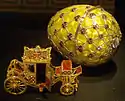 | Viktor Vekselberg | |
| 1897 | Mauve Egg | Only the egg's surprise has survived. | LOST Viktor Vekselberg | |
| 1898 | Lilies of the Valley Egg | 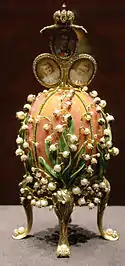 | The egg is one of two in Art Nouveau style. It was presented on April 5 to Tsar Nicholas II, and was used as a gift to the tsaritsa, Empress Alexandra Fyodorovna. | Viktor Vekselberg |
| 1898 | Pelican Egg | Virginia Museum of Fine Arts, Richmond, Virginia, USA | ||
| 1899 | Bouquet of lilies clock egg |  | Kremlin Armoury, Moscow | |
| 1899 | Pansy egg |  | The egg's surprise | Matilda Gray Stream, US |
| 1900 | Trans-Siberian Railway egg |  | Kremlin Armoury, Moscow | |
| 1900 | Cockerel egg |  | Viktor Vekselberg | |
| 1901 | Basket of flowers | .jpg.webp) | Royal Collection, London, United Kingdom | |
| 1901 | Gatchina Palace egg |  | Walters Art Museum, Baltimore, Maryland | |
| 1902 | Clover leaf egg |  | Kremlin Armoury, Moscow | |
| 1902 | Empire nephrite egg | 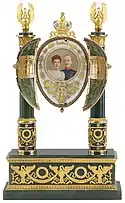 | Surprise – miniature portrait of Grand Duchess Olga Alexandrovna of Russia and Duke Peter Alexandrovich of Oldenburg (original lost) | Private collection, New York City |
| 1903 | Peter the Great egg | 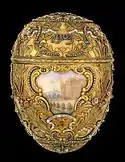 | Virginia Museum of Fine Arts, Richmond, Virginia, USA | |
| 1903 | Royal Danish egg |  | LOST | |
| 1904 | No eggs made | |||
| 1905 | No eggs made | |||
| 1906 | Moscow Kremlin egg |  | Kremlin Armoury, Moscow | |
| 1906 | Swan egg | Edouard and Maurice Sandoz Foundation, Switzerland | ||
| 1907 | Rose trellis egg |  | Walters Art Museum, Baltimore, Maryland, USA | |
| 1907 | Love trophies egg or 'Cradle with garlands' egg | Private Collection | ||
| 1908 | Alexander Palace egg |  | Kremlin Armoury, Moscow | |
| 1908 | Peacock egg | Edouard and Maurice Sandoz Foundation, Switzerland | ||
| 1909 | Standart yacht egg | _02_by_shakko.jpg.webp) | Kremlin Armoury, Moscow | |
| 1909 | Alexander III commemorative egg |  | LOST | |
| 1910 | Colonnade egg |  | Royal Collection, London, UK | |
| 1910 | Alexander III equestrian egg |  | Kremlin Armoury, Moscow | |
| 1911 | Fifteenth anniversary egg |  | Viktor Vekselberg | |
| 1911 | Bay tree egg |  | Also known as the Orange Tree Egg | Viktor Vekselberg |
| 1912 | Tsarevich egg | _and_surprise.jpg.webp) | Virginia Museum of Fine Arts, Richmond, Virginia | |
| 1912 | Napoleonic egg | .jpg.webp) | Matilda Geddings Gray Foundation. Displayed at the Metropolitan Museum of Art, New York | |
| 1913 | Romanov tercentenary egg |  | Kremlin Armoury, Moscow | |
| 1913 | Winter egg | The State of Qatar | ||
| 1914 | Mosaic egg |  | Royal Collection, London, UK | |
| 1914 | Grisaille egg or Catherine the Great egg | .jpg.webp) | The egg was made by Henrik Wigström, Fabergé's last head workmaster. It was given to Maria Fedrovna by her son Nicholas II. Its surprise (now lost) was "a mechanical sedan chair, carried by two blackamoors, with Catherine the Great seated inside".[9] | Hillwood Museum, Washington, D.C., USA |
| 1915 | Red Cross with triptych egg |  | Cleveland Museum of Art, Cleveland, Ohio, USA | |
| 1915 | Red Cross with imperial portraits | -crop.jpg.webp) | Virginia Museum of Fine Arts, Richmond, Virginia | |
| 1916 | Steel military egg | Kremlin Armoury, Moscow | ||
| 1916 | Order of St. George egg | 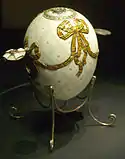 | Made during World War I, the egg commemorates the Order of St. George awarded to Emperor Nicholas and his son, the Grand Duke Alexei Nikolaievich.[10] This and the previous egg were given a modest design in keeping with the austerity of World War I.[11] Fabergé billed 13,347 rubles for the two.[10] The Order of St. George egg left Bolshevik Russia with its original recipient, the Dowager Empress Maria Feodorovna.[12] | Viktor Vekselberg |
| 1917 | Karelian birch egg | Made in 1917, the egg was due to be completed and delivered to the tsar that Easter, as a present for his mother, the Empress Maria Feodorovna. Before the egg could be delivered, the February Revolution took place and Nicholas II was forced to abdicate on March 15. On April 25, Fabergé sent the Tsar an invoice for the egg, addressing Nicholas II not as "Tsar of all the Russians" but as "Mr. Romanov, Nikolai Aleksandrovich". Nicholas paid 12,500 rubles. The egg was sent to Grand Duke Michael Alexandrovich at his palace, for presentation to the empress, but the duke fled before it arrived. The egg remained in the palace until it was looted after the October Revolution. | Alexander Ivanov. Displayed at Ivanov's Fabergé Museum in Baden-Baden, Germany. | |
| 1917 | Constellation egg |  | Because of the Russian Revolution, this egg was never finished or presented to Tsar Nicholas's wife, the Tsaritsa Alexandra Feodorovna. Two eggs have claims to be the Constellation egg: one held at Fersman Mineralogical Museum in Moscow and the other in the possession of Alexander Ivanov and displayed at Ivanov's Fabergé Museum in Baden-Baden, Germany. | Fersman Mineralogical Museum, Moscow or the Fabergé Museum in Baden-Baden. |
List of the Kelch eggs
Faberge also made eggs for Alexander Kelch, a Siberian gold mine industrialist, as gifts for his wife Barbara (Varvara) Kelch-Bazanova. Most are copies of other eggs.
| Date | Egg | Image | Description | Owner |
|---|---|---|---|---|
| 1898 | Kelch Hen Egg | .jpg.webp) | Viktor Vekselberg | |
| 1899 | Twelve Panel Egg | Royal Collection, London, UK | ||
| 1900 | Pine Cone Egg | Private collection | ||
| 1901 | Apple Blossom Egg |  | Liechtenstein National Museum | |
| 1902 | Rocaille Egg |  | Dorothy and Artie McFerrin collection | |
| 1903 | Bonbonnière Egg | Private collection | ||
| 1904 | Kelch Chanticleer Egg |  | Viktor Vekselberg |
Other Fabergé eggs
| Date | Egg | Image | Description | Owner |
|---|---|---|---|---|
| 1885–91 | Blue Striped Enamel Egg | Private collection | ||
| 1902 | Duchess of Marlborough Egg |  | Viktor Vekselberg | |
| 1902 | Rothschild Egg | 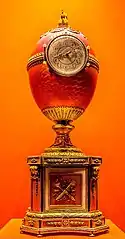 | Hermitage Museum, Saint Petersburg, Russia | |
| 1907 | Youssoupov Egg | Edouard and Maurice Sandoz Foundation, Switzerland | ||
| 1914 | Nobel Ice Egg | .jpg.webp) | Dorothy and Artie McFerrin collection | |
| 1885–89 | Resurrection Egg |  | possibly the surprise from the 1894 Renaissance Egg[13] | Viktor Vekselberg |
| 1899–1903 | Spring Flowers Egg |  | Possibly not Fabergé | Viktor Vekselberg |
| 1899–1903 | Scandinavian Egg |  | Viktor Vekselberg | |
| 1895 | Egg-Stamp | A seal, made of red gold, surrounding the upper part of the Egg and bowenite, decorated with 19 diamonds. At the top of the Egg six rubies, cabochons on garlands, and three rubies, cabochons on the chest of the cherubs. | Private collection |
References
- "Faberge Egg, In Classic Style, History, Easter Egg, James Bond | In Classic Style". Archived from the original on 2012-06-25. Retrieved 2015-09-30.
- "A Fabergé egg is not just for Easter". 23 March 2008. Retrieved 10 September 2019 – via www.telegraph.co.uk.
- Egg Week: The story behind the world's largest and most expensive Easter egg hunt | National Post
- "The Third Imperial Faberge Easter Egg at Wartski". Archived from the original on 2014-07-04. Retrieved 2015-09-30.
- Singh, Anita (18 March 2014). "The £20m Fabergé egg that was almost sold for scrap". The Telegraph. Retrieved 19 March 2014.
- Housed in the Metropolitan Museum of Art in New York City, New York, planned to be till 2016. "Fabergé from the Matilda Geddings Gray Foundation Collection November 22, 2011–November 27, 2016". Museum of Modern Art. Retrieved 2015-09-05.
- Displayed in the Metropolitan Museum of Art in New York City, New York.
- Hillwood Museum have identified the twelve monograms Egg previously dated to 1895 as the Alexander III portraits egg of 1896, Archived 2014-04-16 at the Wayback Machine
- "Hillwood Estate, Museum & Gardens - The Catherine the Great Egg". hillwoodmuseum.org. Archived from the original on 4 December 2013. Retrieved 10 September 2019.
- "Faberge - Treasures of Imperial Russia". Archived from the original on 2007-07-28. Retrieved 2015-09-30.
- "Mieks Fabergé". August 2013. Archived from the original on 2015-04-23. Retrieved 2015-09-30.
- "Faberge". Treasures of Imperial Russia. Archived from the original on 2007-07-28. Retrieved 2012-03-26.
- "Faberge - Treasures of Imperial Russia". 21 September 2013. Archived from the original on 2013-09-21. Retrieved 10 September 2019.
This article is issued from Wikipedia. The text is licensed under Creative Commons - Attribution - Sharealike. Additional terms may apply for the media files.